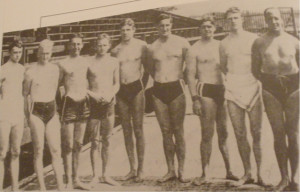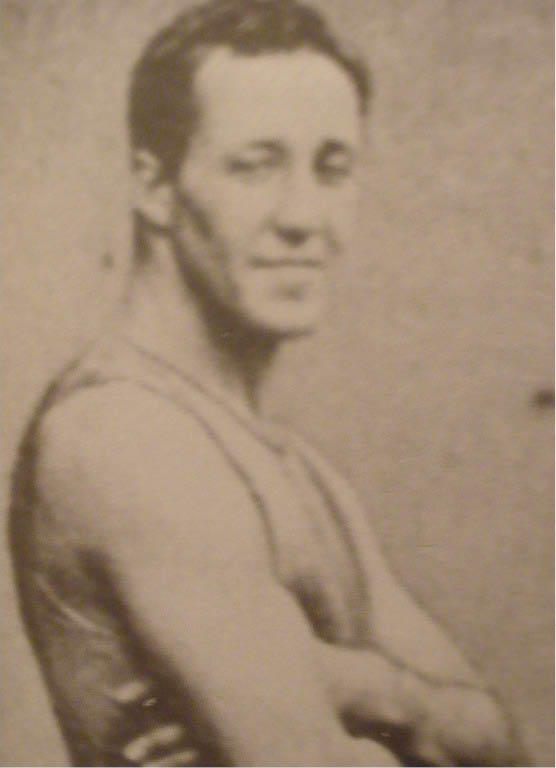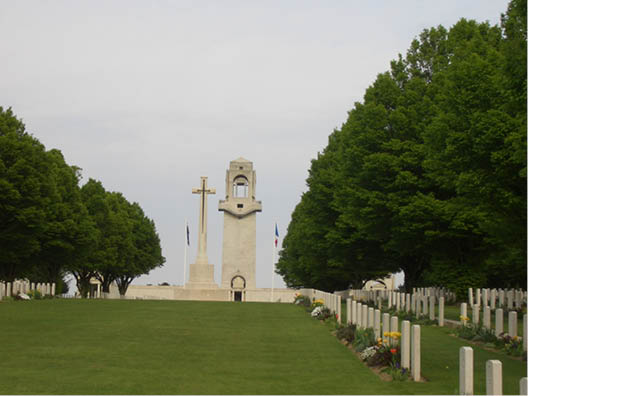JOHN McNAMEE REPORTS ON THE MOVING SEARCH TO FIND A DIGGER’S FINAL RESTING PLACE
Military historians believe they are getting closer to solving the 90-year-old mystery of the “missing soldier of the 19th Battalion” who fought and died alongside one of Australia’s first Olympic champions.
Reuben Alfred Russell was killed in action during the Battle of the Somme in World War I…one of more than 3000 Australian casualties involved in the horrendously fierce Battle of Mont St Quentin , near Peronne, in the Picardy region of France.
He had been a member of the 19th Battalion, AIF, part of the 2nd Division, Fifth Brigade. Among their foe in the powerful German divisions on that day was the elite 2nd German Guard, known for the ferocity of their fighting.
Russell and 22 of his comrades-in-arms were gunned down by savage machine gun fire during a flanking attack on the heavily defended Mont St Quentin hillside on August 31/September 1, 1918.
The graves of the men in this close-knit fighting unit have, over the intervening years, been found and their remains identified. All except Russell’s.
Retired colonel Graham Fleeton of Military History Tours in Sydney told Go55s that all of the 22 Diggers killed in that action on that day had been exhumed from their makeshift battlefield graves after the war and re-interred in Commonwealth war cemeteries.
Eight of them had been buried at Assevillers including Cecil Patrick Healy, one of the pioneers of Australian swimming and an Olympic gold medallist.
But there was one name missing from among the dead.
CECIL HEALY: Olympic champion, killed in action on the Somme
It was that of Reuben Russell.
Although his name is written on the main memorial wall at Villers-Bretonneux war cemetery, his burial site remains a mystery.
During their investigations into Russell’s final resting place, the military team hope to have found a memorial stone which carries the epitaph “Known Only To God”, used when the deceased cannot be identified.
“We’re not sure even if the unknown grave is that of an Australian, but it is in the Assevillers cemetery along with Healy and the others and we can only hope that it is the grave of Reuben Russell,” Mr Fleeton said.
“He must be there somewhere, we know he can’t be buried too far away from his mates. We feel we’re getting closer.
“It would be marvellous if we could confirm that the headstone is that of the Australian and then we can work back, maybe get some DNA evidence and try to trace some living relatives,” Mr Fleeton said.
“it is a particularly moving exercise because we know that the unit he fought in was Cecil Healy’s and being an Olympic hero at the time, that must have made for some wonderful camaraderie,’ he said.
The battle of Mont St Quentin was a decisive counteroffensive in the Battle of the Somme and the Australians, after prolonged hand-to-hand fighting and machine gun barrages, had broken through the German lines.
The Australian advance was described at the time by the British high command as one of the greatest military achievements of the war.
However, it came at horrific cost and the Australian casualties numbered over three thousand.
Three Australians were awarded the Victoria Cross for their role in the battle:
- Albert David Lowerson, aged 22, 21st Battalion, originally from Myrtleford, Victoria. (Died 1945)
- Robert MacTier, aged 28, 23rd Battalion, originally from Tatura, Victoria, who died in the action.
- Edgar Thomas Towner, aged 28 2nd Machine Gun Battalion, from Blackall, Queensland. (Died 1972)
At the time of his death aged 34 on that fateful day of battle, Cecil Healy had been a Second Lieutenant in the 19th Battalion after enlisting in the Australian defence forces in September 1915 following his spectacular sporting career. He was at first a Quartermaster-Sergeant before completing his Officer Training in Cambridge.
His fame would have spread throughout the Australian fighting forces along the Somme battlefields.
The war cemetery at Villers-Bretonneaux where the name of themissing soldier Reuben Russell is inscribed on the wall.
Not only was he one of the Australian pool and surf champions credited with introducing the iconic Aussie “crawl” stroke, but Healy had been one of the first men to have beaten the mighty Frank Beaurepaire, who was then classed as the greatest swimmer of the era.
Healy, who was also a noted surf swimmer and lifesaver with the North Steyne and Manly clubs, was known as a great sportsman and it was this quality which had cost him a gold medal at the 1912 Olympics in Stockholm, an event which involved the legendary pioneer of surfing, the Hawaiian-American Duke Kahanamoku.
It was in the heats and semis of the 100m freestyle at the Games and Healy had qualified with fellow Australian Bill Longworth along with the American but due to a management error on the part of the Yanks, the “Duke’’ was disqualified from the final.
In a magnificent act of sportsmanship Healy helped the American’s appeal against the ruling and it was sensationally overturned allowing the “Duke” to compete in a separate semi and thus qualify.
Kahanamoku easily won the gold that seemed destined to be Healy’s who finished up with the silver.
But Healy, famously, was not to be denied. He teamed up with Leslie Boardman, Malcolm Champion of New Zealand (it was a combined team in those days) and his old sparring partner Harold Hardwick to win the 4x200m freestyle relay.
(Coincidentally, 40 years later at the 1956 Olympics Australia again won the event as they did another 40 years later at the Sydney Games in 2000.)
The current commanding officer of 1/19th Battalion, Royal NSW Regiment, Lieut Colonel Peter Morrissey who is actively supporting the venture to confirm Reuben Russell’s burial place, told Go55s there was huge interest these days in tracing the fate of World War I Diggers.
This was evident from the recent ceremony at Fromelles where the last of the 250 soldiers found in a mass grave were re-buried with great ceremony in the new military cemetery.
“The finding of our missing soldier would close another chapter in our regiment’s long history,” Lt-Col Morrissey said.
For more information go to www.militaryhistorytours.com.au
Main Picture CECIL HEALY (FAR RIGHT) WITH THE 1912 AUSTRALIAN OLYMPIC SWIMMING TEAM INCLUDING (FAR RIGHT) HAROLD HARDWICK





9 Comments
Nice post..thank you
Reuben Alfred Russell was the great uncle of my wife, Shirley (nee Russell). Reuben was killed at Ticker Copse on 31/8/1918.
We would be happy to cooperate in any way to confirm the identity of the unknown soldier who could possibly be Reuben Russell.
Likewise to Andrew my wife Marie(nee Russell) Shirley’s older sister would like to thank you for your diligent ongoing research and offer any assistance we can which may be of help to confirm this mans identity…when necessary.Thank you for such a lovely article.
I came across the story of Reuben A Russell when researching a relative who also died in action in WW1. He seems to have been assigned the same serial number, “5392 Private”. This seems rather odd to me, so if you happen to know why/how this can happen, then I would be most grateful to hear from you.
Meantime, I understand (from my limited research to date) that Private 5392, my great great uncle Thomas Manners, was buried in Belgium, while Private 5392 Reuben Alfred Russell was buried at Villers in France (www.ww1cemetaries.com).
Possibly you know this already, or perhaps the website is mistaken. I’d love to hear any further progress you may have made…
Dear Tracey Just noticed your query on Go55. There does not appear to be any error in the duplicate Military Service number. Unlike WW2 where the were unique service numbers for each servicemen, many WWI soldiers had the same number as the numbers were allocated for each regiment and were therefore known as regimental numbers. The AIF Project website lists 30 soldiers with the number 5392. Unfortunately there has been no further progress on Reuben Russell. We now know that he does not appear to be one of the soldiers recently found and reported by Go55. We are patiently waiting like many others but his remains will probably never be found. Regards Andrew Graham
Thank you for this article which pays homage to one of Australia’s great lost sporting legends, Cecil Healy. Unfortunately you have incorrectly captioned the picture: Healy is actually shown on the far right of the picture. As Healy’s biographer, I just wanted to point this out. Regards,
Rochelle Nicholls
Thank you Rochelle, it is a great article and I will pass your comments regarding the picture to the author John McNamee
Reuben Alfred Russell was my great uncle he was my grand father Harold James older brother.
Reuben Alfred Russell was my Uncle. His Sister Dorothy Thelma Deane (nee Russell) was my mother.
As with a number of the other respondents I would be happy to help wherever possible in any DNA checking or other areas of solving this mystery and laying him to a final rest.